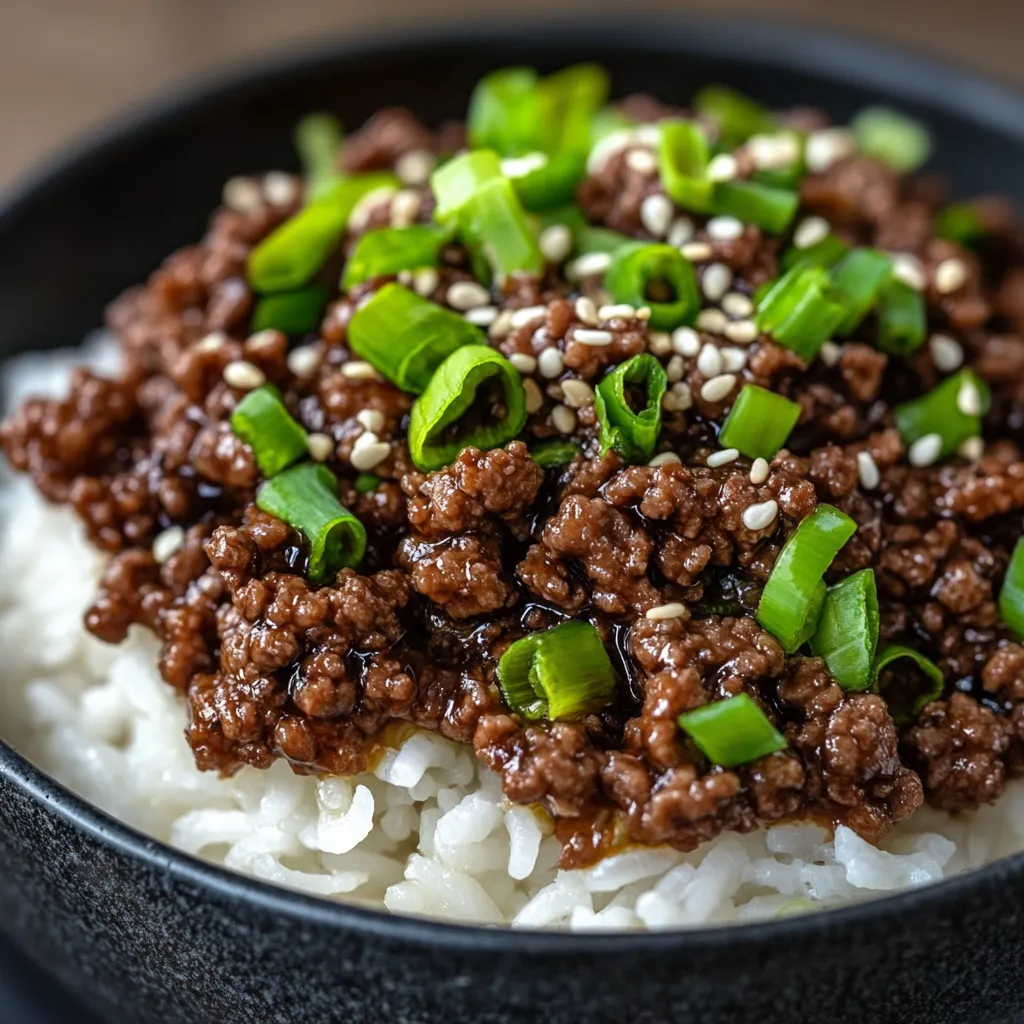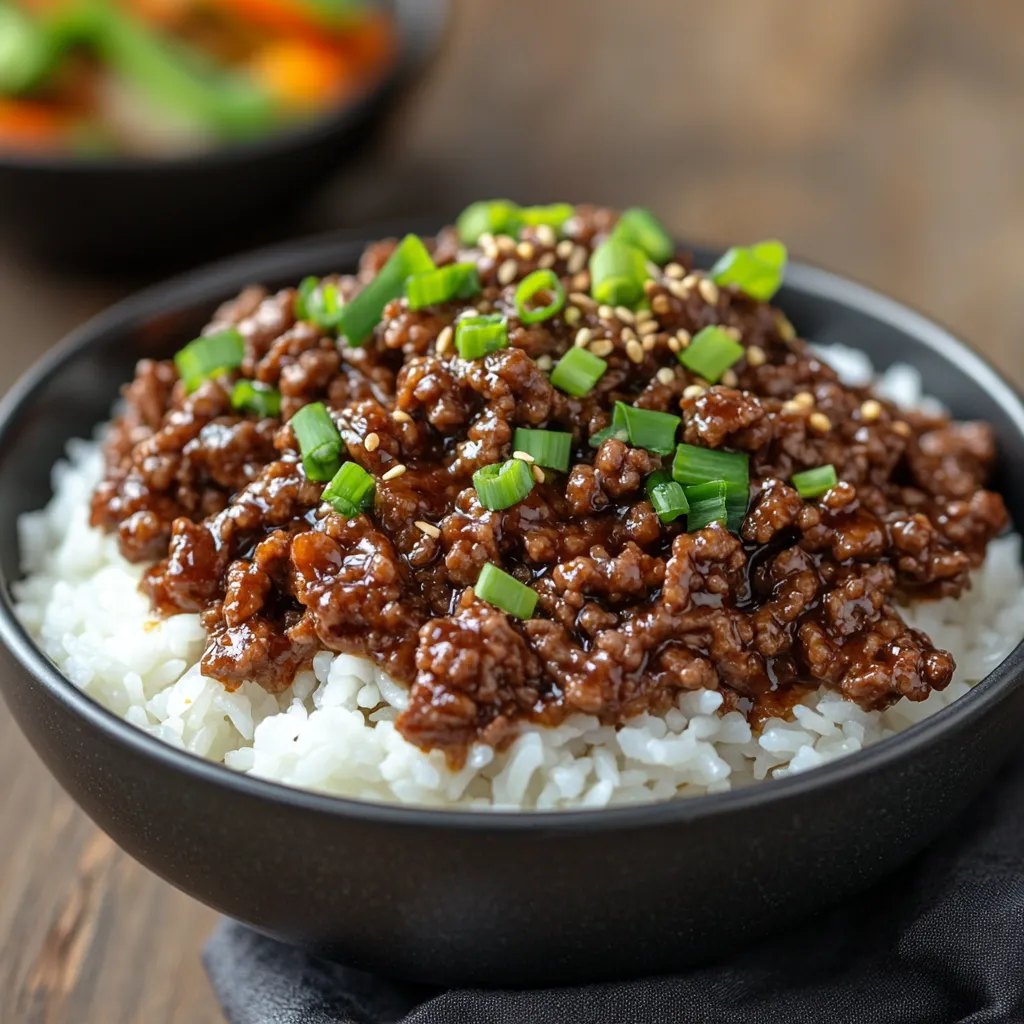 Save
Save
This Korean ground beef bowl has become my weeknight dinner hero, delivering authentic Korean flavors in just 25 minutes without compromising on taste. The combination of savory beef with aromatic garlic and ginger creates a dish that feels like restaurant quality but requires minimal effort.
I first made this recipe during a particularly hectic work week when I needed something quick but satisfying. My family was so impressed they requested it three times that same month, and it has since become our go to solution when takeout cravings strike but we want something healthier and more affordable.
Ingredients
- Ground beef 80/20 provides the perfect balance of flavor and texture. The fat content helps carry the seasonings and creates juicy results
- Soy sauce delivers that essential umami flavor backbone. I recommend using low sodium if you're watching salt intake
- Sesame oil brings authentic Korean flavor that cannot be substituted. A little goes a long way
- Fresh garlic and ginger create aromatic depth. Fresh truly makes a difference compared to powdered versions
- Green onions add brightness and color. Look for perky stems with vibrant green tops
- Rice serves as the perfect canvas. Jasmine rice has a subtle fragrance that complements the beef beautifully
- Optional toppings like sesame seeds and kimchi take this dish to the next level of authenticity
Step-by-Step Instructions
- Prepare the Rice
- Cook your rice according to your preferred method. For jasmine rice, I rinse it thoroughly first to remove excess starch, then use a 1 to 2 rice to water ratio. The key is allowing the rice to rest for 5 minutes after cooking before fluffing with a fork. This step ensures perfectly separated grains rather than mushy rice.
- Brown the Beef
- Start with a hot skillet before adding your ground beef. This creates proper browning rather than steaming. Use a wooden spoon to break the beef into small pieces as it cooks, creating more surface area for the seasonings to cling to. Cook until just barely no pink remains, as it will continue cooking when you add other ingredients.
- Create the Flavor Base
- Add minced garlic and ginger directly to the beef rather than beforehand. This protects these delicate aromatics from burning while allowing their oils to blend with the beef fat. Stir constantly during this phase to prevent sticking and to evenly distribute the flavors throughout the meat.
- Add the Sauce Elements
- Pour in soy sauce and drizzle sesame oil over the beef mixture. The hot pan will cause these liquids to sizzle and immediately begin reducing, creating a glossy coating on the beef. This rapid reduction concentrates flavors and creates that characteristic Korean sticky quality without needing a separate sauce.
- Assemble with Intention
- Layer components thoughtfully beginning with rice at the bottom. This absorbs the savory juices from the beef. Add the beef next, then arrange any vegetables around the perimeter for visual appeal. Finish with garnishes sprinkled from a height to ensure even distribution.

The minced ginger is truly the secret weapon in this recipe. I discovered its importance when I once made the dish without it, and the flavor profile was completely different. Now I keep frozen ginger on hand which I can easily grate directly into the pan without even thawing it first. My children initially claimed to dislike ginger but have never once complained about this dish the fine mince distributes the flavor without overwhelming bites.
Storing Your Korean Beef Bowl
This dish stores remarkably well in the refrigerator for up to 4 days. The flavors actually intensify overnight as the beef continues to absorb the seasonings. I recommend storing the rice and beef mixture separately if possible, as this prevents the rice from becoming overly saturated. When reheating, add a small splash of water to the rice to revive its texture, and heat the beef separately until just hot throughout to prevent drying out.
Perfect Pairings
Korean beef bowls welcome numerous side dishes that enhance the meal experience. Traditional banchan like cucumber kimchi or quick pickled radishes provide palate cleansing acidity between bites. For a simple approach, steam broccoli or sugar snap peas while the beef cooks they require no additional seasoning as they will absorb flavors from the beef when combined in your bowl. A fried egg with a runny yolk served on top creates a luxurious sauce when broken that coats every grain of rice.
Making It Authentic
While this recipe is simplified for weeknight cooking, several touches can increase authenticity. Gochujang Korean chili paste can replace or supplement some of the soy sauce for a spicy variation true to Korean flavor profiles. Korean cooking often includes a touch of sweetness I sometimes add 1 tablespoon of brown sugar or honey to balance the savory elements. Market availability permitting, using thinly sliced sirloin instead of ground beef creates a version closer to traditional bulgogi with similar flavor notes.

Recipe FAQs
- → What rice works best for this Korean beef bowl?
Jasmine, basmati, or brown rice all work wonderfully. Jasmine offers a fragrant aroma, basmati provides fluffy individual grains, and brown rice adds nutritional benefits. Choose based on your preference and cooking time available - white rice varieties cook faster than brown.
- → Can I make this dish gluten-free?
Absolutely! Simply substitute regular soy sauce with tamari or coconut aminos. Double-check that your sesame oil is processed in a gluten-free facility, and you'll have a delicious gluten-free meal.
- → What vegetables can I add to this Korean beef bowl?
This dish is incredibly versatile. Try adding thinly sliced bell peppers, shredded carrots, steamed broccoli, or wilted spinach. For authentic Korean flavors, consider adding kimchi or quick-pickled vegetables as toppings.
- → How can I make this dish spicy?
To add heat, incorporate 1-2 teaspoons of gochujang (Korean chili paste), a drizzle of sriracha, or red pepper flakes to taste. You can adjust the spice level by adding these ingredients during cooking or as a topping.
- → Can I meal prep this Korean beef bowl?
This dish is excellent for meal prep! The beef mixture keeps well in the refrigerator for 3-4 days. Store the cooked beef and rice separately, then reheat and assemble when ready to eat. Fresh toppings like green onions are best added just before serving.
- → What's the best type of ground beef to use?
An 80/20 lean-to-fat ratio offers optimal flavor, but you can use leaner options like 90/10 if preferred. The fat content helps keep the meat juicy and flavorful. For a healthier alternative, ground turkey or chicken can be substituted.
